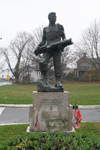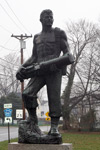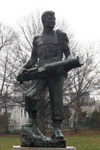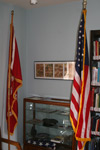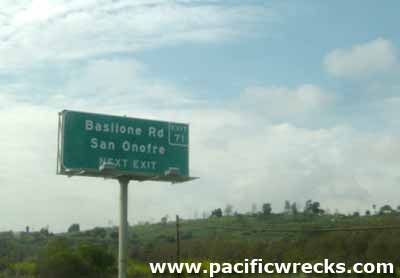Gy/Sgt John F. Basilone
United States Marine Corps (USMC)
Medal of Honor Guadalcanal and Killed In Action Iwo Jima
Background
John Francis Basilone was born November 4, 1916 to parents Salvatore Basilone and Theodora (née Benivenga) Basilone the sixth of ten children of parents in Buffalo, New York. His father, Salvatore Basilone emigrated from just outside Naples, Italy in 1903. At age 19 and settled in Manville, New Jersey. He went to St. Bernard Parochial School in Raritan and after completing school at age fifteen he dropped out before attending high school to enlist in the military.
Military Service
Basilone enlisted in the U.S. Army and served in the Philippines for three years and was a champion boxer. After returning home, he became a truck driver in Reisterstown, Maryland. After a few months he wanted to go back to Manila and believed he could get there fastest by joining the U.S. Marine Corps (USMC).
In July 1940, Basilone
enlisted in the U.S. Marines in Baltimore, Maryland and went to recruit training at Parris Island followed by training at Marine Corps Base Quantico and New River. In the Marines, he had service number 287506 and was nicknamed "Manila John" due to his prior Philippine service. Basilone was sent to Guantanamo Bay, Cuba and assigned to the 1st Battalion, 7th Marines. On September 18, 1942 landed with the 7th Marines as reinforcements on Guadalcanal.
Guadalcanal
On October 24, 1942 Basilone manned a forward position with a .30 caliber machine gun on a ridge line east of Hill 80 on Bloody Ridge (Edson's Ridge). On October 25, 1942 at 1:15am, furtherest to the west, the Japanese Army 3rd Battalion, 9th Company charged straight into the Company C line. Within five minutes, Marine machine gun positions led by Sgt John Basilone opened fire killing nearly all the attackers. During the assault, Basilone moved an extra gun into position and maintained continual fire against the incoming Japanese soldiers. He repaired another machine gun and personally manned it, holding the defensive line until replacements arrived. During the continuous fighting, ammunition became critically low and when the supply lines were cut off he personally brought forward .30 caliber ammunition for his gunners. By the end of the battle, the attacking Japanese were virtually annihilated.
John Basilone machine gun position where he earned the Medal of Honor on Bloody Ridge
Stills from video by Justin Taylan, 2003
Medal of Honor
For his actions on October 24-25, 1942 Basilone later earned the Medal of Honor. At a ceremony in the Melbourne Cricket Ground (MCG) in Melbourne, four Marines: General Alexander A. Vandegrift, Col. Merritt A. Edson, Plat/Sgt Mitchell Paige and Sgt John Basilone were each bestowed the Medal of Honor.
Medal of Honor
 "For extraordinary heroism and conspicuous gallantry in action against enemy Japanese forces, above and beyond the call of duty, while serving with the 1st Battalion, 7th Marines, 1st Marine Division in the Lunga Area. Guadalcanal, Solomon Islands, on 24 and 25 October 1942. While the enemy was hammering at the Marines' defensive positions, Sgt. Basilone, in charge of 2 sections of heavy machine guns, fought valiantly to check the savage and determined assault. In a fierce frontal attack with the Japanese blasting his guns with grenades and mortar fire, one of Sgt. Basilone's sections, with its gun crews, was put out of action, leaving only 2 men able to carry on. Moving an extra gun into position, he placed it in action, then, under continual fire, repaired another and personally manned it, gallantly holding his line until replacements arrived. A little later, with ammunition critically low and the supply lines cut off, Sgt. Basilone, at great risk of his life and in the face of continued enemy attack, battled his way through hostile lines with urgently needed shells for his gunners, thereby contributing in large measure to the virtual annihilation of a Japanese regiment. His great personal valor and courageous initiative were in keeping with the highest traditions of the U.S. Naval Service." "For extraordinary heroism and conspicuous gallantry in action against enemy Japanese forces, above and beyond the call of duty, while serving with the 1st Battalion, 7th Marines, 1st Marine Division in the Lunga Area. Guadalcanal, Solomon Islands, on 24 and 25 October 1942. While the enemy was hammering at the Marines' defensive positions, Sgt. Basilone, in charge of 2 sections of heavy machine guns, fought valiantly to check the savage and determined assault. In a fierce frontal attack with the Japanese blasting his guns with grenades and mortar fire, one of Sgt. Basilone's sections, with its gun crews, was put out of action, leaving only 2 men able to carry on. Moving an extra gun into position, he placed it in action, then, under continual fire, repaired another and personally manned it, gallantly holding his line until replacements arrived. A little later, with ammunition critically low and the supply lines cut off, Sgt. Basilone, at great risk of his life and in the face of continued enemy attack, battled his way through hostile lines with urgently needed shells for his gunners, thereby contributing in large measure to the virtual annihilation of a Japanese regiment. His great personal valor and courageous initiative were in keeping with the highest traditions of the U.S. Naval Service." |
Return Home
Basilone returned to the United States as a war hero and participated in a war bond tour. His arrival was highly anticipated and publicized and his hometown of Raritan, New Jersey held a parade in his honor on September 19, 1943 that drew a crowd of thousands including politicians, celebrities, and was reported nationally. Despite his fame, Basilone requested to return to combat duty. The Marine Corps denied his request and he was told he was needed more on the home front. He was offered a commission as an officer and a stateside assignment as instructor, but he declined both.
After repeated requests, Basilone's request to return to combat was approved. On December 27, 1943 he departed for Camp Pendleton, California for training and met his future wife, U.S. Marine Corps Women's Reserve Sergeant Lena Mae Riggi. On July 10, 1944 the couple was married at St. Mary's Church in Oceanside with a reception at the Carlsbad Hotel. They honeymooned at her parents' onion farm in Portland. Afterwards, he requested a return to combat in the Pacific.
Iwo Jima
Basilone was assigned to the Machine Gun Platoon of Company C, 1st Battalion, 27th Marine Regiment, 5th Marine Division for the invasion of Iwo
Jima. On February 19, 1945 he and his platoon were on Red Beach on Iwo
Jima and were pinned down by enemy gunfire. He single-handedly destroyed an enemy blockhouse, allowing his unit to capture Motoyama No. 1 Airfield and later aided a friendly tank which was trapped in an enemy mine field under an intense mortar and artillery barrage. He guided the heavy vehicle over the hazardous terrain to safety, despite heavy weapons fire from the Japanese. As he moved along the edge of the airfield, an exploding mortar shell instantly killed him. Posthumously, Basilone earned the Navy Cross, the Marines second highest award for valor.
Navy Cross
 "For extraordinary heroism while serving as a Leader of a Machine-Gun Section, Company C, 1st Battalion, 27th Marines, 5th Marine Division, in action against enemy Japanese forces on Iwo Jima in the Volcano Islands, 19 February 1945. Shrewdly gauging the tactical situation shortly after landing when his company's advance was held up by the concentrated fire of a heavily fortified Japanese blockhouse, Gunnery Sergeant Basilone boldly defied the smashing bombardment of heavy caliber fire to work his way around the flank and up to a position directly on top of the blockhouse and then, attacking with grenades and demolitions, single handedly destroyed the entire hostile strong point and its defending garrison. Consistently daring and aggressive as he fought his way over the battle-torn beach and up the sloping, gun-studded terraces toward Airfield Number 1, he repeatedly exposed himself to the blasting fury of exploding shells and later in the day coolly proceeded to the aid of a friendly tank which had been trapped in an enemy mine field under intense mortar and artillery barrages, skillfully guiding the heavy vehicle over the hazardous terrain to safety, despite the overwhelming volume of hostile fire. In the forefront of the assault at all times, he pushed forward with dauntless courage and iron determination until, moving upon the edge of the airfield, he fell, instantly killed by a bursting mortar shell. Stouthearted and indomitable, Gunnery Sergeant Basilone, by his intrepid initiative, outstanding skill, and valiant spirit of self-sacrifice in the face of the fanatic opposition, contributed materially to the advance of his company during the early critical period of the assault, and his unwavering devotion to duty throughout the bitter conflict was an inspiration to his comrades and reflects the highest credit upon Gunnery Sergeant Basilone and the United States Naval Service. He gallantly gave his life in the service of his country." "For extraordinary heroism while serving as a Leader of a Machine-Gun Section, Company C, 1st Battalion, 27th Marines, 5th Marine Division, in action against enemy Japanese forces on Iwo Jima in the Volcano Islands, 19 February 1945. Shrewdly gauging the tactical situation shortly after landing when his company's advance was held up by the concentrated fire of a heavily fortified Japanese blockhouse, Gunnery Sergeant Basilone boldly defied the smashing bombardment of heavy caliber fire to work his way around the flank and up to a position directly on top of the blockhouse and then, attacking with grenades and demolitions, single handedly destroyed the entire hostile strong point and its defending garrison. Consistently daring and aggressive as he fought his way over the battle-torn beach and up the sloping, gun-studded terraces toward Airfield Number 1, he repeatedly exposed himself to the blasting fury of exploding shells and later in the day coolly proceeded to the aid of a friendly tank which had been trapped in an enemy mine field under intense mortar and artillery barrages, skillfully guiding the heavy vehicle over the hazardous terrain to safety, despite the overwhelming volume of hostile fire. In the forefront of the assault at all times, he pushed forward with dauntless courage and iron determination until, moving upon the edge of the airfield, he fell, instantly killed by a bursting mortar shell. Stouthearted and indomitable, Gunnery Sergeant Basilone, by his intrepid initiative, outstanding skill, and valiant spirit of self-sacrifice in the face of the fanatic opposition, contributed materially to the advance of his company during the early critical period of the assault, and his unwavering devotion to duty throughout the bitter conflict was an inspiration to his comrades and reflects the highest credit upon Gunnery Sergeant Basilone and the United States Naval Service. He gallantly gave his life in the service of his country." |
Relatives
Lena Mae Riggi Basilone (wife) passed away June 11, 1999 at age 86. She is buried at Riverside National Cemetery at section 50, site 5557.
Memorials
Basilone was officially declared dead on February 19, 1945 at age 28. He was initially buried on Iwo
Jima. Afterwards, his remains were transported to the United State. On April 20, 1948 he was permanently buried at Arlington National Cemetery, section 12, grave 384.
In Raritan, New Jersey a memorial statue featuring him holding a .30 caliber machine gun is located at the intersection of Old York Road and Canal Street. It was sculpted by a childhood friend, Phillip Orlando and dedicated in 1948. The Raritan Public Library has the Basilone Room with memorabilia, photos and articles about him. The Bridgewater-Raritan High School playing field is named "John Basilone Field" in his honor. The new Bridge that crosses the Raritan River in Raritan at First Avenue and Canal Street is named in his honor.
The Knights of Columbus Council #13264 in Raritan is named in his honor. A bust in Little Italy San Diego at Fir & India Streets called "Piazza Basilone". Order Sons of Italy In America Lodge #2442 is named in honor of Sgt. John Basilone in Bohemia, New York. A plaque at the United States Navy Memorial in Washington, D.C.
An overpass is named in his honor at the Somerville Circle in Somerville, New Jersey on U.S. Highway 202 and 206. The New Jersey Turnpike bridge across the Raritan River is named the "Basilone Bridge". The bridge on the NJ turnpike near the
Elizabeth exit that has a bronze plaque and is named in honor of Basilone.
USS Basilone (DD-824) launched on December 21, 1945 was sponsored by Sgt. Lena Mae Basilone, USMCWR, John Basilone's widow.
In California, Basilone Memorial Highway is a stretch of I-5 Highway between San Diego and Los Angeles near Camp
Pendelton. Also, there is a Basilone
Road nearer to the base.
Basilone's medal of honor is displayed at the National Museum of the U.S. Marine Corps (USMC Museum).
References
Portrait of Sgt. John Basilone (1944) by C. C. Beall
Colliers Magazine June 24, 1944 cover artwork portrait of Sgt. John Basilone by C. C. Beall
Congressional Medal of Honor Society - John "Manila John" Basilone
Arlington National Cemetery - John Basilone Section 12, Grave 384
Arlington National Cemetery (ANC Explorer) -
John Basilone (grave photos)
FindAGrave - GYSGT John Francis Basilone (photo, grave photo)
FindAGrave - Sgt Lena Mae Riggi Basilone (photos, grave photo)
Red Blood Black Sand (1995) by Charles W. Tatum details Basilone at Camp Pendleton and death on Iwo Jima
You'll Be Sor-ree! (2010) by Sidney "Sid" Phillips attends the Medal of Honor ceremony at the Melbourne Cricket Ground (MCG)
The Pacific Episode 2 depicts Basilone October 24, 1942 action on Guadalcanal
The Pacific Episode 3 depicts Basilone earning the Medal of Honor
The Pacific Episode 7 depicts Basilone selling war bonds and promoting the war effort in the United States
The Pacific Episode 8 depicts Basilone at Camp Pendleton and death on Iwo Jima
Contribute
Information
Do you have photos or additional information to add?
|



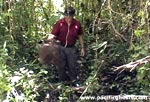
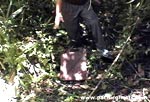
 "For extraordinary heroism and conspicuous gallantry in action against enemy Japanese forces, above and beyond the call of duty, while serving with the 1st Battalion, 7th Marines, 1st Marine Division in the Lunga Area. Guadalcanal, Solomon Islands, on 24 and 25 October 1942. While the enemy was hammering at the Marines' defensive positions, Sgt. Basilone, in charge of 2 sections of heavy machine guns, fought valiantly to check the savage and determined assault. In a fierce frontal attack with the Japanese blasting his guns with grenades and mortar fire, one of Sgt. Basilone's sections, with its gun crews, was put out of action, leaving only 2 men able to carry on. Moving an extra gun into position, he placed it in action, then, under continual fire, repaired another and personally manned it, gallantly holding his line until replacements arrived. A little later, with ammunition critically low and the supply lines cut off, Sgt. Basilone, at great risk of his life and in the face of continued enemy attack, battled his way through hostile lines with urgently needed shells for his gunners, thereby contributing in large measure to the virtual annihilation of a Japanese regiment. His great personal valor and courageous initiative were in keeping with the highest traditions of the U.S. Naval Service."
"For extraordinary heroism and conspicuous gallantry in action against enemy Japanese forces, above and beyond the call of duty, while serving with the 1st Battalion, 7th Marines, 1st Marine Division in the Lunga Area. Guadalcanal, Solomon Islands, on 24 and 25 October 1942. While the enemy was hammering at the Marines' defensive positions, Sgt. Basilone, in charge of 2 sections of heavy machine guns, fought valiantly to check the savage and determined assault. In a fierce frontal attack with the Japanese blasting his guns with grenades and mortar fire, one of Sgt. Basilone's sections, with its gun crews, was put out of action, leaving only 2 men able to carry on. Moving an extra gun into position, he placed it in action, then, under continual fire, repaired another and personally manned it, gallantly holding his line until replacements arrived. A little later, with ammunition critically low and the supply lines cut off, Sgt. Basilone, at great risk of his life and in the face of continued enemy attack, battled his way through hostile lines with urgently needed shells for his gunners, thereby contributing in large measure to the virtual annihilation of a Japanese regiment. His great personal valor and courageous initiative were in keeping with the highest traditions of the U.S. Naval Service."



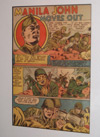




 "For extraordinary heroism while serving as a Leader of a Machine-Gun Section, Company C, 1st Battalion, 27th Marines, 5th Marine Division, in action against enemy Japanese forces on Iwo Jima in the Volcano Islands, 19 February 1945. Shrewdly gauging the tactical situation shortly after landing when his company's advance was held up by the concentrated fire of a heavily fortified Japanese blockhouse, Gunnery Sergeant Basilone boldly defied the smashing bombardment of heavy caliber fire to work his way around the flank and up to a position directly on top of the blockhouse and then, attacking with grenades and demolitions, single handedly destroyed the entire hostile strong point and its defending garrison. Consistently daring and aggressive as he fought his way over the battle-torn beach and up the sloping, gun-studded terraces toward Airfield Number 1, he repeatedly exposed himself to the blasting fury of exploding shells and later in the day coolly proceeded to the aid of a friendly tank which had been trapped in an enemy mine field under intense mortar and artillery barrages, skillfully guiding the heavy vehicle over the hazardous terrain to safety, despite the overwhelming volume of hostile fire. In the forefront of the assault at all times, he pushed forward with dauntless courage and iron determination until, moving upon the edge of the airfield, he fell, instantly killed by a bursting mortar shell. Stouthearted and indomitable, Gunnery Sergeant Basilone, by his intrepid initiative, outstanding skill, and valiant spirit of self-sacrifice in the face of the fanatic opposition, contributed materially to the advance of his company during the early critical period of the assault, and his unwavering devotion to duty throughout the bitter conflict was an inspiration to his comrades and reflects the highest credit upon Gunnery Sergeant Basilone and the United States Naval Service. He gallantly gave his life in the service of his country."
"For extraordinary heroism while serving as a Leader of a Machine-Gun Section, Company C, 1st Battalion, 27th Marines, 5th Marine Division, in action against enemy Japanese forces on Iwo Jima in the Volcano Islands, 19 February 1945. Shrewdly gauging the tactical situation shortly after landing when his company's advance was held up by the concentrated fire of a heavily fortified Japanese blockhouse, Gunnery Sergeant Basilone boldly defied the smashing bombardment of heavy caliber fire to work his way around the flank and up to a position directly on top of the blockhouse and then, attacking with grenades and demolitions, single handedly destroyed the entire hostile strong point and its defending garrison. Consistently daring and aggressive as he fought his way over the battle-torn beach and up the sloping, gun-studded terraces toward Airfield Number 1, he repeatedly exposed himself to the blasting fury of exploding shells and later in the day coolly proceeded to the aid of a friendly tank which had been trapped in an enemy mine field under intense mortar and artillery barrages, skillfully guiding the heavy vehicle over the hazardous terrain to safety, despite the overwhelming volume of hostile fire. In the forefront of the assault at all times, he pushed forward with dauntless courage and iron determination until, moving upon the edge of the airfield, he fell, instantly killed by a bursting mortar shell. Stouthearted and indomitable, Gunnery Sergeant Basilone, by his intrepid initiative, outstanding skill, and valiant spirit of self-sacrifice in the face of the fanatic opposition, contributed materially to the advance of his company during the early critical period of the assault, and his unwavering devotion to duty throughout the bitter conflict was an inspiration to his comrades and reflects the highest credit upon Gunnery Sergeant Basilone and the United States Naval Service. He gallantly gave his life in the service of his country."



